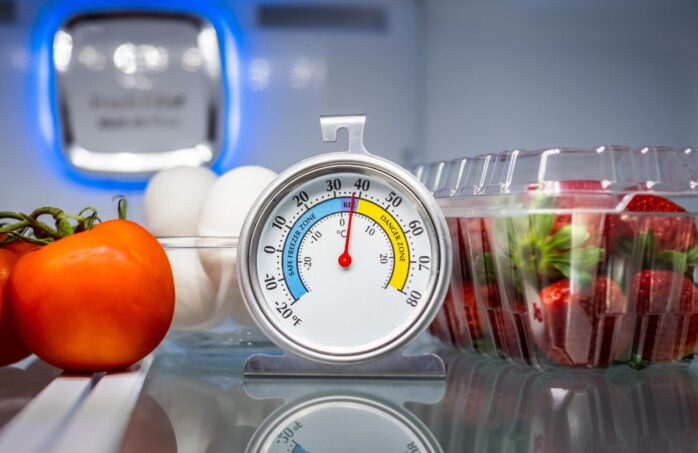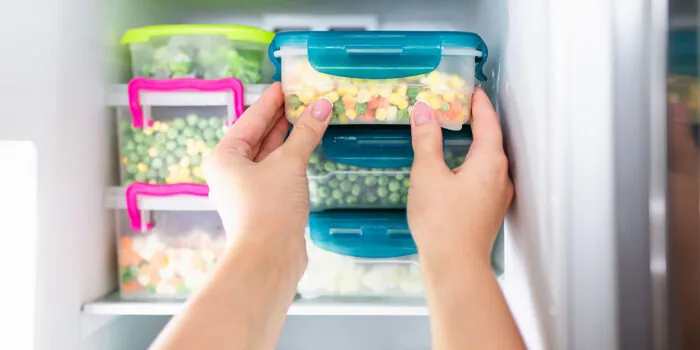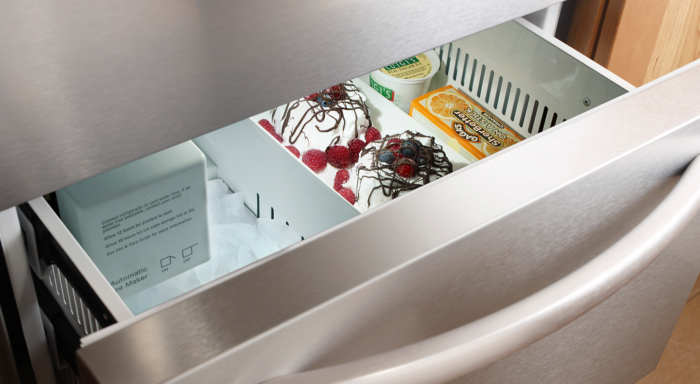
Why maintaining the right fridge temperature is essential?
Ensures food Safety:
Keeping the right temperature slows the growth of harmful bacteria, reducing the risk of foodborne illnesses.
Food Preservation:
Lower temperatures extend the freshness and shelf life of various foods, reducing waste.
Preserve Nutrients:
Proper temperature helps preserve the nutritional value of food items.
Maintains Food Quality and Taste:
It maintains the intended texture and flavour of your food.
Prevents Cross-Contamination:
Proper temperatures reduce the risk of harmful bacteria transfer between items.
Improves Energy Efficiency:
Maintaining the correct temperature saves on energy bills and reduces your environmental impact.
Minimises Odour:
It helps prevent unpleasant odours from developing in your fridge.
Ensures Compliance with Food Safety Regulations:
Commercial establishments must maintain the right temperature to meet food safety regulations and protect customers.

Recommended fridge temperature range
Maintaining the recommended fridge temperature range is fundamental for both small and vertical fridges to ensure food safety and preserve stored items.
The ideal temperature range for the fridge compartment typically remains the same for both small and vertical fridges, with specific temperature values falling between 32°F to 40°F (0°C to 4°C).
This range is chosen carefully to create an environment that effectively inhibits the growth of harmful bacteria, which tend to thrive at higher temperatures, while also preventing the freezing of more sensitive food items, which can occur at lower temperatures. In small fridges, where space is limited, this ideal range is equally important.
Frequent door openings and compact size may lead to more rapid temperature fluctuations, making it essential to monitor and adjust the temperature settings consistently to maintain the correct range.
Vertical fridges, however, often boast efficient temperature distribution due to their size and design. However, adherence to the recommended temperature range remains crucial.
By using a reliable fridge thermometer in both small and vertical fridges, you can ensure that they consistently operate within the safe and optimal temperature range, regardless of their size or configuration.
This practice ensures the longevity, safety, and quality of the food you store, whether working with the limited space of a small fridge or the convenience of a vertical one, both of which play a vital role in daily kitchen operations.
Tools and methods to measure your fridge temperature
Measuring fridge temperature is a crucial practice for ensuring food safety and preservation.
There are various tools and methods available to monitor fridge temperature effectively. These include traditional fridge thermometers, digital temperature monitors, and built-in temperature displays on modern fridges.
To ensure the accuracy and reliability of your fridge thermometer, it’s essential to calibrate and maintain it regularly, following the manufacturer’s guidelines. This ensures that the readings are consistently precise, allowing you to make informed decisions about the safety and quality of the food stored in your fridge.
Whether you opt for a basic thermometer or a more advanced digital device, regular monitoring with a trustworthy instrument is key to maintaining the recommended temperature range and safeguarding the freshness and safety of your stored items.
Making seasonal temperature adjustments
Making seasonal adjustments to small and vertical fridges is essential to optimise food preservation and energy efficiency. During the hot summer months, it’s advisable to slightly lower the fridge temperature to counteract the warmer ambient temperatures and ensure food safety.
Conversely, in the winter, when the surroundings are cooler, you can raise the fridge temperature to conserve energy without compromising the freshness of your food.
Additionally, consider factors like humidity, which can affect food storage. For instance, in the summer, you might need to adjust the humidity settings to keep fruits and vegetables fresh.
These seasonal adaptations help maintain the ideal temperature range and address specific temperature-related challenges, ultimately ensuring your small and vertical fridges are tailored to the unique demands of different times of the year.

Common Fridge Temperature Mistakes to Avoid
Avoiding common fridge temperature mistakes is crucial for preserving food safety and quality. Some prevalent errors include setting the temperature too high, causing bacterial growth, or too low, leading to frozen and damaged food.
Inconsistent temperature monitoring and improper placement of the fridge thermometer can also result in inadequate temperature control.
These mistakes can lead to foodborne illnesses, spoilage, and food waste. It’s essential to regularly check and adjust your fridge’s temperature settings, place the thermometer in the right spot, and ensure your fridge door seals properly.
By addressing these common errors, you can maintain the recommended temperature range, safeguard the freshness of your food, and prevent safety issues and unnecessary waste.
Efficient energy management in your fridge
Maintaining the recommended temperature range conserves energy and reduces greenhouse gas emissions. When your fridge runs at the correct temperature, it doesn’t have to work as hard to keep food cool, resulting in lower energy consumption and, subsequently, reduced electricity bills.
This not only saves you money but also reduces the environmental footprint associated with electricity generation. By minimising energy use, you contribute to a decrease in carbon emissions and environmental impact, ultimately playing a role in mitigating climate change.
Efficient fridge temperature management is a simple yet effective way to promote both eco-friendliness and economic savings in your daily life.

Conclusion
In conclusion, understanding and maintaining the ideal fridge temperature is paramount for ensuring food safety, preserving the quality of your groceries, and reducing energy consumption. The recommended temperature range strikes a balance between preventing harmful bacterial growth and preserving the freshness of your food.
Regular monitoring with a reliable fridge thermometer and making seasonal adjustments when necessary are key practices to uphold the integrity of your fridge’s temperature. By adhering to these guidelines, you not only protect your health and reduce food waste but also contribute to environmental conservation by using your fridge more efficiently.
So, the next time you open your fridge, remember that the temperature settings play a critical role in safeguarding both your family’s well-being and the planet.











